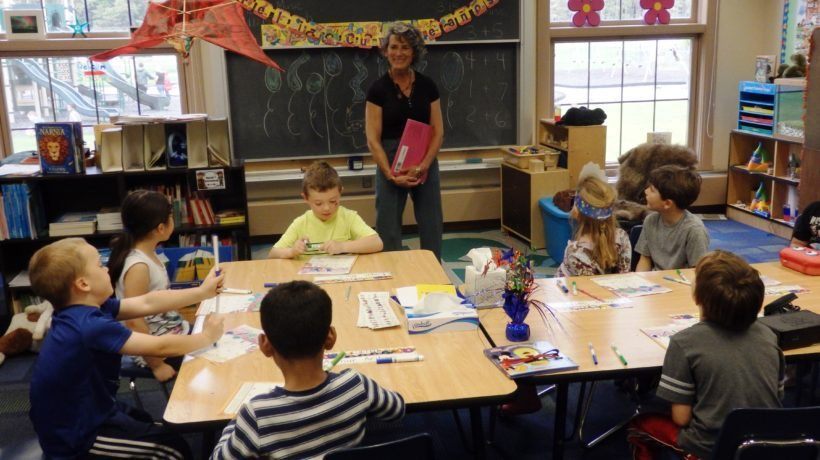The Importance Of A Dedicated Learning Space At Home
Kids learn better with a steady routine and structure, and having a set place for learning helps them excel in their studies. When your child knows there's a designated learning space at home for their homework, projects, and online lessons, their brain shifts easily to "study mode." A clutter-free, well-organized space helps them concentrate better. When everything they need is within reach—pens, paper, headphones—there's less time wasted searching for supplies and more time spent actually learning.
Additionally, a dedicated learning space at home helps set boundaries between work and relaxation. When your child sits in their learning spot, they know it's time to get serious. And when they leave it, they can switch back to being carefree. It's like a mental exercise that helps them transition between different activities smoothly. Without further ado, let's explore how you can make this happen, as well as insider tips on how to organize your child's learning materials online.
How To Create A Distraction-Free Environment
Setting Up The Workspace
The most important aspect of creating a dedicated learning space for young students at home is choosing the perfect location. You must pick a quiet place, ideally not the living room or kitchen, where people come and go all the time. A corner of your kid's bedroom is more appropriate. To equip the learning spot, choose comfortable and ergonomic furniture and, surely, proper lighting. Of course, don't forget to personalize the spot, decorating it with whatever interests your child. This will make them feel more engaged in the process and actually enjoy spending time in their learning space.
Device Management
It's easy for kids to get distracted when they have internet access. So, you need to implement some device management techniques, such as using apps or settings that limit access to non-educational content. This doesn't have to be for all the devices in the house, just for those they use for learning. You can even set time limits if your kid really needs a short break for scrolling. Most importantly, you should set a Do Not Disturb on their phones during classes and study hours. Maybe set rules like "no phones until the end of the chapter." That will keep them from getting distracted by the constant notifications.
Reducing Noise
When learning from home, there's bound to be some noise in the background: someone watching TV, a dog barking, or someone speaking on the phone. So, how do you create a peaceful environment? First up, equip your kid with noise-canceling headphones. These block every sound from the outside world so your child can focus solely on their lessons. However, what's most effective is setting some house rules. During the time they study, inform the rest of the household that they should keep noise levels to a minimum. As long as you're managing noise and distractions, you are in control of how much they're engaged in the learning process.
Establishing A Routine
Few things encourage productivity like a steady learning and studying routine does. Your kids need specific times for everything they do during learning hours, whether it's studying or taking a break. This helps them stay focused and build good habits; if they know that their homework time is at 6 p.m., they'll be less likely to complain when you ask them to study. However, schedules must be flexible. For instance, if your child struggles with a subject, it's okay to extend their study time. On the other hand, if they have mastered a concept, they should be able to spend less time studying it.
5 Tips To Organize Learning Materials
1. Cloud Storage
Using cloud storage means no more losing files. Plus, your kids can access their learning materials anytime, from any device, whether they're on their laptop, phone, or even your iPad. If your child accidentally forgets to hit "Save," cloud storage's auto-backup has them covered. Another perk is that cloud storage helps them when they have to collaborate with their peers on group projects. They can share documents and work on them together with their classmates in real time. This way, they'll be able to track changes, meaning they'll know exactly who contributed what.
2. Organizational Tools And Apps
There are many organizational tools and apps that specialize in managing and organizing tasks, files, and assignments. These also help your kids keep track of deadlines and all the things they have to do. Plus, they're perfect for organizing the learning materials. All your kid needs to do is create folders for each subject, subfolders for dates, and drop the files there. If they want to take the organization to the next step, they can color-code folders and add automation each time they complete a task. So, no more scrolling and searching to find files or check completed assignments; they're all there, just a click away.
3. Digital Calendar
A digital calendar is a must-have when learning online. Even if you've built the perfect schedule for your kid, it's no use if they can't keep track of it. A digital calendar does exactly that: it ensures your kid's on schedule and notifies them when they're not. To begin, your child should create a calendar for each subject and give it a color. By the time they're done, their calendar will be filled with colored slots corresponding to their lessons. Next, they should add time slots for their study sessions. They can even add notes on what they'll cover during that time. But, most importantly, they should enable notifications. Digital reminders are perfect for upcoming study sessions and modules, leaving no room for excuses like "I forgot."
4. Checklist
Calendars and schedules are perfect, but a checklist is what keeps young learners from slacking. Your kid can start by writing down every single task they need to tackle for their online courses. This includes everything from readings to assignments and quizzes. They should also categorize them into daily, weekly, and monthly tasks or even add some of their goals there. They can use either digital or physical tools for that, but keep in mind that digital checklists integrate seamlessly into digital calendars and send notifications straight to your kid's phone.
5. Backup Files
Imagine the computer suddenly shutting off and all your kid's study notes disappear. That's why having backup copies is nonnegotiable. In fact, you should set up a backup system for your child as soon as possible. Cloud storage surely backs up files, as mentioned above, but it's not always enough to keep your online learning materials safe. For example, what if they are offline and need to access some resources? External hard drives or USB sticks are perfect for this and should be kept somewhere safe.
Conclusion
Staying focused can be tough for kids learning online, especially with all the distractions out there. One of the best things you can do as a parent is to create a dedicated, clutter-free learning space at home for them. It doesn't have to be too fancy—just a quiet corner with minimal distractions. Encouragement is also important. You should celebrate their achievements, and if they're struggling, try to spot the reason and work together to address it. By being actively involved and supportive, you're helping your child build a strong relationship with learning and studying, which is a key element of their academic success.









